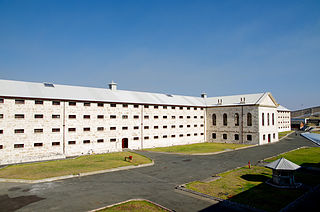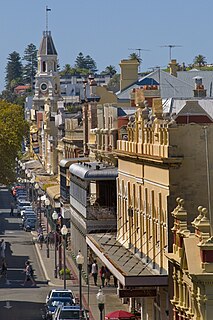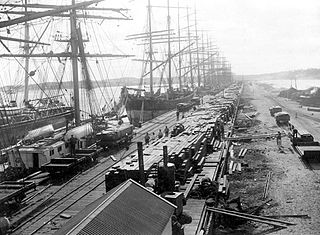
Wagin is a town and shire in the Great Southern region of Western Australia, approximately 225 km (139.81 mi) south-east of Perth on the Great Southern Highway between Narrogin and Katanning. It is also on State Route 107. The main industries are wheat and sheep farming.

Fremantle Prison, sometimes referred to as Fremantle Gaol or Fremantle Jail, is a former Australian prison and World Heritage Site in Fremantle, Western Australia. The six-hectare (15-acre) site includes the prison cellblocks, gatehouse, perimeter walls, cottages, and tunnels. It was initially used for convicts transported from Britain, but was transferred to the colonial government in 1886 for use for locally-sentenced prisoners. Royal Commissions were held in 1898 and 1911, and instigated some reform to the prison system, but significant changes did not begin until the 1960s. The government department in charge of the prison underwent several reorganisations in the 1970s and 1980s, but the culture of Fremantle Prison was resistant to change. Growing prisoner discontent culminated in a 1988 riot with guards taken hostage, and a fire that caused $1.8 million worth of damage. The prison closed in 1991, replaced by the new maximum-security Casuarina Prison.

The Brisbane Trades Hall is a former Trades Hall building in Edward Street Brisbane, Queensland, Australia.

The Perth Trades Hall is a historic trades hall building in Perth that has been occupied by various organisations of the Western Australian trade union movement. The building is now the WA headquarters of the Construction, Forestry, Maritime, Mining and Energy Union (CFMEU).

Civil disturbances in Western Australia include race riots, prison riots, and religious conflicts – often Protestant versus Catholic groups.

Hampton Road is the main road entering the City of Fremantle from the south. It is named after John Stephen Hampton, the Governor of Western Australia from 1862 to 1868. It continues into Ord Street at the north east corner of Fremantle Prison at Knutsford Street.

High Street is the main street running through the City of Fremantle, Western Australia. The street passes by historic landmarks, including the Round House, the Fremantle Town Hall, and the Fremantle War Memorial, through the Fremantle West End Heritage area and through two town squares. Trams operated along High Street for 47 years, between 1905 and 1952. Running east–west, High Street continues as Leach Highway, a major arterial road, at Stirling Highway, linking Fremantle with Perth Airport although the stretch of road between Stirling Highway and Carrington Street is known locally—and signed—as High Street.

Walyalup Koort, formerly known as Kings Square , is a town square in Fremantle, Western Australia. It is bounded by Queen, Newman, William, and Adelaide Streets. Though the square was originally a public reserve, it has been the site of Saint John's Church of England since 1843, and the Fremantle Town Hall since 1887. High Street was extended through and beyond the square in the 1880s, but the portion through the square was closed off in the 1960s. Today Walyalup Koort functions as a civic and cultural centre of Fremantle, with modern events taking place adjacent to the historic buildings.

The 1919 Fremantle Wharf riot, also known as the Battle of the Barricades, arose out of a strike by stevedores in Fremantle, Western Australia in 1919. The strike was called by the Waterside Workers' Federation (WWF) over the use of National Waterside Workers Union (NWWU) workers to unload the quarantined ship Dimboola, and escalated into fatal violence when WWF workers and supporters attempted to prevent NWWU members from carrying out the work.

Trinity Church is one of the oldest church buildings in the City of Perth, and one of the few remaining 19th-century colonial buildings in the city. It is located at 72 St Georges Terrace in Perth, Western Australia.

James Laurence Watts (1849–1925) was a sculptor in Queensland, Australia. He was one of the pioneer sculptors in Australia and his works appear in many Queensland public buildings and places.

The Federal Hotel is located at 23-25 William Street in Fremantle, Western Australia, opposite the Fremantle Town Hall.

The Fremantle Lumpers Union was a trade union formed in 1889 and active until 1946 when it became part of the Waterside Workers' Federation, Fremantle Branch. It was the first union to represent unskilled workers formed in Western Australia.

Scots Presbyterian Church is a Presbyterian church located at 90 South Terrace, on the corner of Norfolk and Parry Streets, in Fremantle, Western Australia. It was the first Presbyterian Church built in Fremantle and one of only six to decline amalgamation with the Uniting Church.

Wilhemsen House, also known as the Elders Building, Elder Building, Barwil House and the Dalgety & Co. Building, is a heritage building located at 11 Cliff Street on the corner of Phillimore Street in the port city of Fremantle, Western Australia. The building dates from the gold rush boom period in the late nineteenth and early twentieth centuries and is of historic significance.
Collie Street is in Fremantle, Western Australia.

Pakenham Street is a street in Fremantle, Western Australia, in the Fremantle West End Heritage area. It runs between Phillimore Street and Collie Street, the main cross intersection being with High Street.

The Fremantle Synagogue is a heritage listed building located on South Terrace on the corner of Parry Street in Fremantle, Western Australia. It was the first synagogue built in Western Australia and was associated with Jewish community leaders and merchants in Fremantle at the end of the 19th century. The building is also known as Beers building.

The P&O Hotel is a heritage listed building located at 25 High Street on the corner of Mouat Street in Fremantle, Western Australia. It was one of many commercial buildings constructed in Fremantle during the gold boom period in the late nineteenth and early twentieth century.

Higham's Buildings is a heritage listed building located at 101 High Street, on the corner of Market Street in the Fremantle West End Heritage area. It is one of many commercial buildings constructed in Fremantle during the gold boom period in the late nineteenth and early twentieth century.























